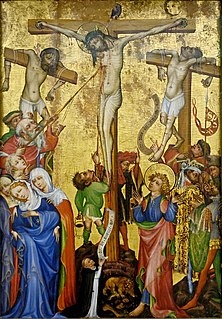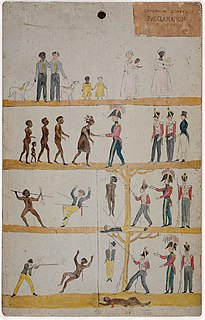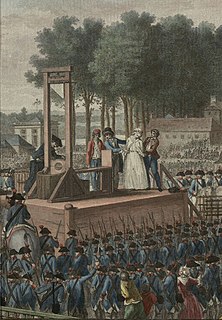 W
WA referendum on the death penalty was held in the United States Virgin Islands on 7 November 1978, in response to a decree by the Governor of the Islands. He requested a non-binding consultative referendum be held in conjunction with the next general election.
 W
WA referendum on the death penalty for premeditated murder was held in Bermuda on 12 August 1990. The referendum was held following pressure from the British government, and was held as part of the Capital Punishment Referendum Act, 1989. However, voters approved of retaining the penalty, with 79% voting in favour.
 W
WThe breaking wheel or execution wheel, also known as the Catherine wheel or simply the Wheel, was a torture method used for public execution primarily in Europe from antiquity through the Middle Ages into the early modern period by breaking the bones of a criminal, and/or bludgeoning him or her to death. The practice was abolished in Bavaria in 1813 and in the Electorate of Hesse in 1836: the last known execution by the "Wheel" took place in Prussia in 1841. In the Holy Roman Empire it was a "mirror punishment" for highwaymen and street thieves, and was set out in the Sachsenspiegel for murder, and arson that resulted in fatalities.
 W
WIn certain countries illegal importing, exporting, sale, or possession of drugs constitute capital offences that may result in the death penalty. A March 2018 report by Harm Reduction International says: "There are at least 33 countries and territories that prescribe the death penalty for drug offences in law. ... Between January 2015 and December 2017, at least 1,320 people are known to have been executed for drug-related offences - 718 in 2015; 325 in 2016; and 280 in 2017. These estimates do not include China, as reliable figures continue to be unavailable for the country."
 W
WThe death penalty has been completely abolished in all European countries except for Belarus and Russia, the latter of which has a moratorium and has not conducted an execution since September 1996. The absolute ban on the death penalty is enshrined in both the Charter of Fundamental Rights of the European Union (EU) and two widely adopted protocols of the European Convention on Human Rights of the Council of Europe, and is thus considered a central value. Of all modern European countries, San Marino, Portugal and the Netherlands were the first to abolish capital punishment, whereas only Belarus still practices capital punishment in some form or another. In 2012, Latvia became the last EU Member State to abolish capital punishment in wartime.
 W
WCrucifixion is a method of punishment or capital punishment in which the victim is tied or nailed to a large wooden beam and left to hang perhaps for several days, until eventual death from exhaustion and asphyxiation. It was used as a punishment by the Romans. Crucifixion has been used in parts of the world as recently as the twentieth century.
 W
WDecapitation, also known as beheading, is the total separation of the head from the body. Such an injury is invariably fatal to humans and most other animals, since it deprives the brain of oxygenated blood, while all other organs are deprived of the involuntary functions that are needed for the body to function.
 W
WDecimation was a form of Roman military discipline in which every tenth man in a group was executed by members of his cohort. The discipline was used by senior commanders in the Roman Army to punish units or large groups guilty of capital offences, such as cowardice, mutiny, desertion, and insubordination, and for pacification of rebellious legions. The word decimation is derived from Latin meaning "removal of a tenth". The procedure was an attempt to balance the need to punish serious offences with the realities of managing a large group of offenders.
 W
WAn execution warrant is a writ that authorizes the execution of a condemned person. An execution warrant is not to be confused with a "license to kill", which operates like an arrest warrant but with deadly force instead of arrest as the end goal.
 W
WAn executioner, also known as a hangman or headsman, is an official who carries out a sentence of capital punishment on a legally condemned person.
 W
WFlaying, also known colloquially as skinning, is a method of slow and painful execution in which skin is removed from the body. Generally, an attempt is made to keep the removed portion of skin intact.
 W
WA gibbet is any instrument of public execution, but gibbeting refers to the use of a gallows-type structure from which the dead or dying bodies of criminals were hanged on public display to deter other existing or potential criminals. Occasionally, the gibbet was also used as a method of execution, with the criminal being left to die of exposure, thirst and/or starvation. The term gibbet may also be used to refer to the practice of placing a criminal on display within a gibbet. This practice is also called "hanging in chains".
 W
WGovernor Davey's Proclamation is a misnomer for an illustrated proclamation issued in Tasmania by the British government after 1 November 1828. Although attributed to Governor Davey it was first authorised by Lieutenant Governor George Arthur. Several illustrated narrative versions of the proclamation were created over time. Many of these four-strip pictograms were originally painted onto Huon pine boards using oil paints. Of approximately 100 proclamation boards produced there are seven known to survive in public collections.
 W
WIncapacitation in the context of criminal sentencing philosophy is one of the functions of punishment. It involves capital punishment, sending an offender to prison, or possibly restricting their freedom in the community, to protect society and prevent that person from committing further crimes. Incarceration, as the primary mechanism for incapacitation, is also used as to try to deter future offending.
 W
WAt Italy's instigation, the UN moratorium on the death penalty resolution was presented by the EU in partnership with eight co-author member States to the General Assembly of the United Nations, calling for general suspension of capital punishment throughout the world. It was twice affirmed: first, on 15 November 2007 by the Third Committee, and then subsequently reaffirmed on 18 December by the United Nations General Assembly resolution 62/149. New Zealand played a central role facilitating agreement between the co-author group and other supporters.
A Peshotanu, meaning one who pays with his body, according to Avestan terminology, is a person who had either been condemned to or previously subjected to two hundred stripes with the Aspahe-astra and the Sraosho-karana. Two hundred flogs with a whip was a capital punishment in Ancient Persia next only to death. A Peshotanu was also designated margarzan or "worthy of death".
 W
WA public execution is a form of capital punishment which "members of the general public may voluntarily attend." This definition excludes the presence of a small number of witnesses randomly selected to assure executive accountability. The purpose of such displays has historically been to deter individuals from defying laws or authorities. Attendance at such events was historically encouraged and sometimes even mandatory.
 W
WA scaffold is a raised, stage-like site for public executions.
 W
WThe term Scharfrichter refers specifically to a tradition of executioners in the German states. Using a sword of execution, they had the responsibility of actually executing prisoners; his assistant, the "Löwe" (lion), would carry out tasks such as forcibly conveying prisoners to the presence of a judge, "rubbish clearance", burying unwanted bodies, and carrying out brandings. The Scharfrichter was a well-known figure nicknamed the "Mate of Death" and instantly recognizable in their traditional black frock coat and silk top hat.
 W
WSkinning is the act of skin removal. The process is done with animals, mainly as a means to prepare the muscle tissues beneath for consumption or for use of the fur or tanning of the skin. The skin may also be used as a trophy, sold on the fur market, or, in the case of a declared pest, used as proof of kill to obtain a bounty from a government health, agricultural, or game agency.
 W
WStoning, or lapidation, is a method of capital punishment where a group throws stones at a person until the subject dies from blunt trauma. It has been attested as a form of punishment for grave misdeeds since ancient times. Its adoption in some legal systems has caused controversy in recent decades.